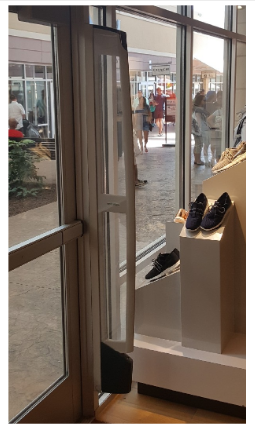A good friend of mine had a great story about how to stop shoplifting. He told me that when he was an Assistant Manager in a very large retail chain some years ago that his Manager had a unique way to deal with the shoplifters they caught. Apparently this was a frequent occurrence at this store. The Manager would tell the two employees that caught and were holding onto the shoplifter in a very convincing tone “We do not have time to wait for the Police to get here. Just take him out back of the store and beat the “stuffing” out of him.”
At this point my friend said most shoplifters would start crying, promise to change their evil ways and never return. My friend said it was both funny and pretty pathetic to watch. Of course, they would then let him go to scamper off into the sunset. But, he did say that after this was done for a while, their shrink losses were less.
To stop shoplifting now, in this century, I would not recommend this course of action. But do not take my word for it, call your Attorney and ask him/her. So if we cannot beat the stuffing out of them then how do we stop shoplifting? Well, in this century we have modern conveniences such as running water, electricity and Sensormatic systems. These systems when used properly with our training will allow you to significantly reduce your shoplifting losses and increase your sales. Increase your sales? Yep, if your merchandise is not being stolen, then it is available to your good customers. On top of that the training we provide, enhances your customer service skills. Enhanced customer service skills with drive away the shoplifter and make your legitimate customers happier. Come on, who does not like good customer service? A knowledgeable employee that is personable and helping with your selections? Oh, yeah shoplifters. THEY HATE CUSTOMER SERVICE.
So can you beat the stuffing out of a shoplifter you catch with a Sensormatic system? Well, no to that also. But in fact by stopping shoplifting through deterrence with a Sensormatic system you are being proactive. Most shoplifters will not steal, if they know you have an active system on guard and customer service oriented employees working the floor. We want to PREVENT the losses from even occurring or even so far as to make the shoplifter think twice and ultimately not steal from you.
But aren’t those systems expensive and they false alarm a lot. No and Yes (kind of). So, NO our Sensormatic systems are available in all budget ranges. You can get a great system at a very affordable price, fully installed. Loss Prevention Systems even has awesome equipment financing. That preserves your cash. So, YES many Radio Frequency (RF) Electronic Article Surveillance (EAS) systems are famous for false alarms including phantom alarms, which are alarms that occur when no one is around the system.
Sensormatic EAS systems are Acousto Magnetic (AM). Without going into technical detail, an AM system has few false or phantom alarms. It is a different technology that has been around 50+ years. That is one of the reasons that Sensormatic is in 80% of the top 200 Retailers world-wide.
So instead of you beating yourself up (or someone else) fix the problem once and for all. We do this every day, day in and day out. Loss Prevention Systems folks are specialists in not just shoplifting prevention but loss prevention in general. We understand employee theft, inventory control, pre-employment background screening and much more.
Do not try to reinvent the wheel. Contact us or call 1-770-426-0547 today to stop shoplifting and learn more about Sensormatic systems.

 Wow, Christmas is over and Retailers are starting to dig out from the carnage. Unfortunately, some of the carnage is all the merchandise that shoplifters have liberated from your store. I believe that theft is actually the oldest vice around. Even older than “the oldest profession”. As long are there are two things on this earth 1-people and 2-stuff, there will be theft. Well, neither is going away anytime soon. So what do we do?
Wow, Christmas is over and Retailers are starting to dig out from the carnage. Unfortunately, some of the carnage is all the merchandise that shoplifters have liberated from your store. I believe that theft is actually the oldest vice around. Even older than “the oldest profession”. As long are there are two things on this earth 1-people and 2-stuff, there will be theft. Well, neither is going away anytime soon. So what do we do?  It is January and you are ready to get started on your new year. What does the start of a New Year look like for your business? Are you still trying to move out seasonal and clearance merchandise? Are you preparing to trim back payroll by releasing seasonal employees? Maybe you are already thinking about inventory and what you will need to do to prepare for that day. There are all sorts of ways retail owners and managers start the New Year but I would suggest that before you look forward you take time to look back on the previous year.
It is January and you are ready to get started on your new year. What does the start of a New Year look like for your business? Are you still trying to move out seasonal and clearance merchandise? Are you preparing to trim back payroll by releasing seasonal employees? Maybe you are already thinking about inventory and what you will need to do to prepare for that day. There are all sorts of ways retail owners and managers start the New Year but I would suggest that before you look forward you take time to look back on the previous year. Have you ever noticed how we all anticipate a New Year will bring new and exciting things into our lives (or businesses) but after the first month we often realize that nothing is new or improved or better? In fact, we may be disappointed as the year progresses that problems we hoped would be resolved (read, “magically disappear”) are still there. We make resolutions at the beginning of the year that are meant to help “improve” or “fix” something we know is an opportunity but then we slide back into our routines and those “problems” don’t get any better.
Have you ever noticed how we all anticipate a New Year will bring new and exciting things into our lives (or businesses) but after the first month we often realize that nothing is new or improved or better? In fact, we may be disappointed as the year progresses that problems we hoped would be resolved (read, “magically disappear”) are still there. We make resolutions at the beginning of the year that are meant to help “improve” or “fix” something we know is an opportunity but then we slide back into our routines and those “problems” don’t get any better. It’s 2019 and time to make some New Year’s resolutions! We all know how easy a resolution can be to make but they are hard to keep. We also know that it is just as easy to break a resolution but are there resolutions a store owner can make that would benefit the store AND benefit society? I think one resolution that would be mutually beneficial for both would be the implementation of environment-friendly policies and procedures. We are talking about sensible measures that would appeal to anyone on either side of the political spectrum. Right now there is a big push for the elimination of plastic shopping bags. There are also those opposed to going back to paper bags. What could the solution be? Try encouraging the use of recyclable, reusable shopping bags for your customers. You make those opposed to one-time use bags happy and you save money on the need to regularly purchase more shopping bags (which can be a rather pricey supply on your monthly expense report). To implement this type of change you would want to have reusable bags ready for your customers and you might even give them away for the first few weeks you start the program. After that, you might give customers a small discount to customers who bring their own bags, say 1% on every transaction.
It’s 2019 and time to make some New Year’s resolutions! We all know how easy a resolution can be to make but they are hard to keep. We also know that it is just as easy to break a resolution but are there resolutions a store owner can make that would benefit the store AND benefit society? I think one resolution that would be mutually beneficial for both would be the implementation of environment-friendly policies and procedures. We are talking about sensible measures that would appeal to anyone on either side of the political spectrum. Right now there is a big push for the elimination of plastic shopping bags. There are also those opposed to going back to paper bags. What could the solution be? Try encouraging the use of recyclable, reusable shopping bags for your customers. You make those opposed to one-time use bags happy and you save money on the need to regularly purchase more shopping bags (which can be a rather pricey supply on your monthly expense report). To implement this type of change you would want to have reusable bags ready for your customers and you might even give them away for the first few weeks you start the program. After that, you might give customers a small discount to customers who bring their own bags, say 1% on every transaction. For a loss prevention officer, the holiday season is a hard time to be jolly when the busiest shopping season of the year brings with it its shoplifters, crime, and theft.
For a loss prevention officer, the holiday season is a hard time to be jolly when the busiest shopping season of the year brings with it its shoplifters, crime, and theft.